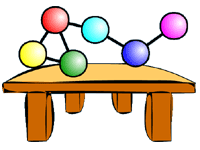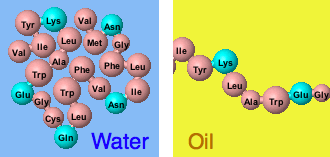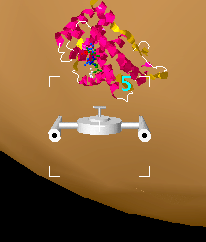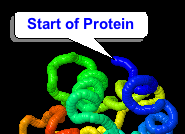User:Eric Martz/Sandbox 6: Difference between revisions
Eric Martz (talk | contribs) |
Eric Martz (talk | contribs) →Notes: x |
||
| Line 131: | Line 131: | ||
==Notes== | ==Notes== | ||
<references /> | <references /> | ||
==See Also== | |||
* The official home page of ''Molecular Workbench'', [http://mw.concord.org mw.concord.org], where you will find an introductory '''movie'''. | |||
Revision as of 23:50, 9 April 2009
Proposed Article Title: Molecular Workbench

|
|
What Is Molecular Workbench?What Is Molecular Workbench?
The Molecular Workbench (MW) project offers free, ready-to-use educational activities as well as software for authoring[1] such educational activities. The existing activities are primarily targeted to the middle and high school levels. College-level activities are under development. MW is the product of the Concord Consortium:
"The Concord Consortium is a nonprofit educational research and development organization based in Concord, Massachusetts. We create interactive materials that exploit the power of information technologies. Our primary goal in all our work is digital equity — improving learning opportunities for all students." (Concord.Org)
All software available from the Concord Consortium is free and open-source.
Molecular Workbench activities are stand-alone programs (in java). They run automatically and quickly from the MW website, and work equally well on Windows and Mac OS X.
What Can Molecular Workbench Do For Me?What Can Molecular Workbench Do For Me?
 |
One of the newest parts of Molecular Workbench (MW) is the Science of Atoms and Molecules (SAM.Concord.Org). It includes:
 |
- Simulations of biochemical, chemical and physical processes are featured. Often students can experiment by controlling parameters of the simulation.
- Protein and DNA molecules are interactive, rotating and change highlighted structural features in Jmol.
 |
- Students can pilot a Molecular Rover to explore the molecular structure structures of hemoglobin or immune system molecules (histocompatibility) to accomplish mission objectives. Some students find the Rover fun and engaging, while for others, learning how to pilot it is frustrating. Enthusiastic pilots could group with those who would rather not pilot. Only a handful of Activities utilize the Rover and these are optional -- most Activities do not use the Rover.
- Students capture snapshots of simulations, interactive molecules, or Rover explorations to document their achievements.

- Snapshot images can be annotated with balloons, and described in open response text notes.
- SAM activities end by generating a report that includes answers to multiple choice questions, annotated snapshots, and the text of open responses. These reports are emailed to the teacher. Students have a chance to edit reports before they are submitted.
- Activities often include multiple choice questions that give immediate feedback to students. Encouraging hints can be given in response to incorrect answers.
- All activities can be downloaded for offline use, in case your Internet connection is problematic.
| Assessment
The immediate feedback and report-generating functions mentioned above provide assessment mechanisms for students and teachers. |
How Do I Get Started?How Do I Get Started?
| Problems Running Molecular Workbench? |
Here are direct links to start a few MW SAM Activities that involve macromolecules (click Trust to permit each to start):
- Four Levels of Protein Structure
- Molecular Recognition & Protein Function
- Proteins and Nucleic Acids
- From DNA to Proteins
Here is a direct link to see the entire list of dozens of SAM activities:
To find the above list of SAM Activities from the Concord Consortium website:
- Start at Workbench.Concord.Org, then
- Click on MW Curriculum.
- At the MW Database, click on SAM. (You can go here directly with SAM.Concord.Org.)
- At SAM, click on Activities, and Trust the java application.
- The MW application (a stand-alone java program) will start. Teachers who want to receive reports, and students who want to be able to send reports to their teacher, must register. If you just want to try the Activities without registering, click on the link "the public main page" near the bottom.
- At the next MW page, click on Activity Center.
Movies of Molecular WorkbenchMovies of Molecular Workbench
Below are a few short movies that illustrate some capabilities of Molecular Workbench.
Balloon AnnotationBalloon Annotation
| Snapshots of simulations and interactive molecules enable students to report their findings. Balloons can be used to label snapshot images. | <swf width="373" height="260">/wiki/images/8/8b/MW_balloon.swf</swf> |
Simulations: Protein FoldingSimulations: Protein Folding
This movie file is large (3 Mb) and may take a few minutes to download. The movie will appear on the right below once download is complete.
| Students conduct experiments with simulations, record their findings in snapshots, and make reports. | <swf width="373" height="260">/wiki/images/d/d1/MW_Protein_Folding_Sim.swf</swf> |
Molecular RoverMolecular Rover
This movie file is large (10 Mb) and may take a few minutes to download. The movie will appear on the right below once download is complete.
| The Molecular Rover is a vehicle that you can pilot to explore molecular structures. Here it is approaching a virus peptide (mostly green and blue) attached to a histocompatibility protein on the surface of a cell. To try out the Rover, go to Rover.Concord.Org. | <swf width="453" height="301">/wiki/images/8/82/MW_rover.swf</swf> |
NotesNotes
- ↑ Authoring Molecular Workbench Activities requires a substantial time commitment.
See AlsoSee Also
- The official home page of Molecular Workbench, mw.concord.org, where you will find an introductory movie.